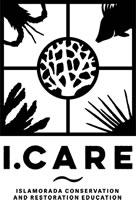The past few weeks, we’ve introduced some of the people working with I.CARE to restore our reefs, but now it’s time to say hello to our real stars: our corals!
At this point, we are transplanting Staghorn and Elkhorn corals onto our reefs in Islamorada. These corals come from Mote Marine Laboratory’s on and offshore coral nurseries. Mote selectively and safely collects wild corals and brings them back to their lab to fragment them and grow hundreds of individual corals from the same parent colony! When they are large enough to put back onto the reef, that’s where I.CARE comes in.
Our partners at Mote also work to assist coral sexual reproduction to produce corals that have the best combination of genotypes to survive harsher conditions. For example, they can take a female coral that survived a bleaching event and a male coral that survived a disease outbreak to produce a baby coral that will have the ability to survive both!
What is a genotype and why do we care? Let’s start with genes: sections of our DNA that encode certain traits. Genes affect our genotype which makes us unique! Our genotypes influence things like our hair or eye color, our height, and susceptibility to diseases. In corals, genotypes affect their morphology, size, and resilience to stressors like disease and warming waters.
We at I.CARE take these “super corals” and transplant them back into the ocean! By transplanting different genotypes of the same coral species, we are increasing genetic diversity on our reefs in Islamorada. When the corals reproduce on their own in the wild, they will spread those diverse genes out over the entire reef system. The more genetic diversity you have in an ecosystem, the more capable it is of handling the problems thrown at it.

